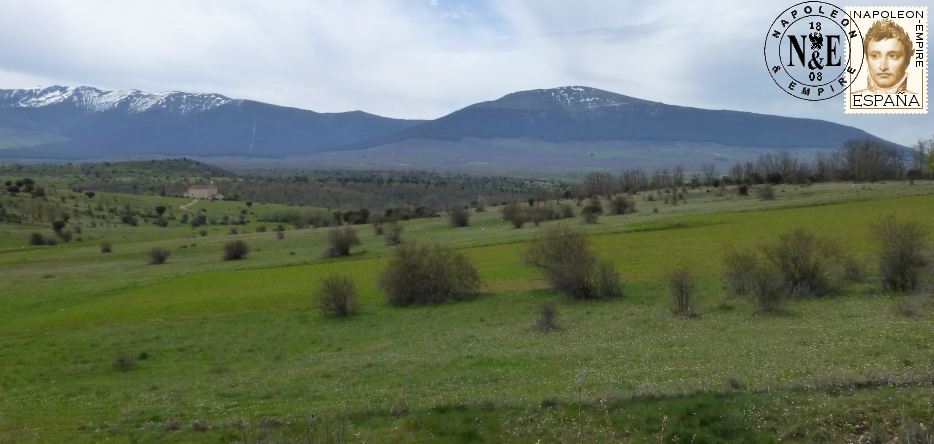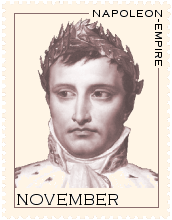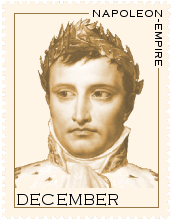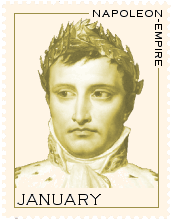Napoleon in Spain day by day
After the defeat of General Pierre Dupont de l'Etang on July 22, 1808 in Bailén in Andalusia, and that of Jean-Andoche Junot on August 21, 1808 in Vimeiro in Portugal, Emperor Napoleon I decided to intervene personally in Spain, at the head of a part of the Grande Armée that he brought from Germany.

The Sierra de Guadarrama, a mountain range north of Madrid
We will detail, day by day, the Emperor's travels during these few weeks (between the crossing of the Pyrenees on the way there and the way back, we total 85 days), illustrating them with an iconography, which will not fail to be enriched on the occasion of our future stays in Spain.
November 1808

- November 3rd - Having left Paris on October 28, Napoleon arrived in the company of Géraud Christophe Duroc in Bayonne, in the Basque Country (the department of Basses-Pyrénées at that time, today the Pyrénées-Atlantiques). He settled in the Château de Marracq, one of his personal properties, which he had acquired in May 1808 [today: a listed monument, but in ruins since a fire in 1825] . He spoke with Louis-Alexandre Berthier.
- November 4 - He wrote to his brother Joseph, King of Spain since June, who was in Vitoria [Vitoria-Gasteiz] and from that moment Napoleon took full control of the army and the administration. Leaving at dawn accompanied by Marshals Jean Lannes and Jean-de-Dieu Soult, he crossed the Bidassoa River which marked the border with Spain, and arrived at six o'clock in the evening in Tolosa, south of San Sebastian [San Sebastian / Donostia], where he was welcomed by General Auguste Julien Bigarré , Joseph's aide-de-camp.
- November 5 - He arrived in the evening in Vitoria , the capital of Alava, and drew up his campaign plan on the basis of the information available, even though he did not have all of his troops at hand (the Imperial Guard and two army corps, the V and VIII, had not yet arrived). He remained there until the 9th, staying at the Etxezarra house, owned by the banker Fernando de la Cuesta, located in the Ariznabarra district, to the west of the city [in our time a district of Vitoria, 42.84114, - 2.68725].
- November 9 - After having learned of the victory of Marshal François Joseph Lefebvre against Don Joaquín Blake y Joyes that had occurred two days before at Gueñès, the Emperor descended on Armiñón, 25 kilometers to the southwest.
- November 10 - While Marshal Soult, at the head of the II Corps, defeated the Extremadura army of General Rámon Rufino Patiño y Pérez-Osorio, Count of Belveder, at Gamonal [today a suburb east of Burgos] (this confrontation is also known as the Battle of Burgos), Napoleon continued towards Cubo de Bureba, to the west-southwest, where he camped.
- November 11 - Having left at one o'clock in the morning, Napoleon and his troops reached Burgos, the cradle of Old Castile, which at that time had 10,000 inhabitants, before daybreak. He reviewed the 108th and 109th regiments, as well as the artillery units of Marshal Bon Adrien Jannot de Moncey's corps. Napoleon would remain in Burgos until the 22nd, staying at the Consulado del Mar [42.34020, -3.70270], where he would receive his brother Joseph for dinner every evening.
- November 12 - He gave orders to reinforce the defenses of the castle overlooking the city.
- November 13 - Napoleon reviewed the troops of Marshal Michel Ney.
- November 14 - He reviewed the division of General Jean-Gabriel Marchand .
- November 15 - He reviewed the Guard and the division of General Jean-Joseph Dessolles .
- November 22 - He went to Villa de Buniel and then to Tardajos, west of Burgos, to review the divisions of Pierre Belon Lapisse and François-Amable Ruffin .
- November 23 - After passing through Burgos where he had an interview with his brother Joseph, Napoleon headed south and reached Aranda de Duero , a wine-producing city renowned since the Middle Ages, around 4 p.m. He stayed there until the 29th, settling in at the Palacio de los Berdugo [at the current number 28 Calle Barrionuevo, 41.67192, -3.68706].
- November 24 - Late in the morning, near the city, he reviewed the division of General Eugène-Casimir Villatte .
- November 27 - He wrote to his brother Joseph, who had remained in Burgos, to come and join him.
- November 29 - He left Aranda in the middle of the morning and went 40 kilometers further south, to Boceguillas . The house in the Plaza Mayor intended to house him having just been destroyed by fire, a tent was erected to welcome the Emperor.
- November 30 - In order to reach Madrid, Napoleon had to cross the Sierra de Guadarrama . He passed through Cerezo de Arriba , and then his army set off, under thick fog, on the road to the Somosierra pass , very well defended by the Spanish under General Benito de San Juan. A terrible battle allowed the Emperor to reach and cross the pass, which peaked at 1,440 metres . In the evening, he slept in Buitrago del Lozoya, 17 kilometers south of the pass.
December 1808

- December 1st - Napoleon resumed his march heading south towards Madrid. He passed through La Cabrera, where he had lunch, and bivouacked in the evening at San Agostino [San Agustín del Guadalix] , 40 kilometers from Madrid.
- December 2nd - He arrived at Chamartín de la Rosa, a village of less than 700 inhabitants [today a district in the north of Madrid] [40.47250, 3.68167]; he settled in the New Palace of the Dukes of the Infantado (College of the Sacred Heart) [which no longer exists today], while his troops occupied the olive grove next to it. He sent a staff officer of Marshal Bessières, then a Spanish lieutenant-colonel taken prisoner to obtain the surrender of the city, all without effect.
- December 3rd - Napoleon bivouacked in front of Madrid, which he had cannonaded after a third refusal by the inhabitants to surrender. An assault was then launched, resulting in the capture of the quarters east of the Paseo del Prado. At five o'clock in the afternoon, he received at the camp General Tomás de Morla y Pacheco , one of the members of the military junta, and Don Bernardo Yriarte , envoy from the city; he lectured them and gave them until the next morning to present the surrender of the city
- December 4 - At six o'clock in the morning, the Emperor received a delegation led by Generals Morla and Fernando de la Vera y Pantoja, who came to sign the capitulation demanded the day before . That same day, he signed decrees abolishing feudal rights and the Inquisition, reducing the number of convents by a third and removing customs barriers between the country's provinces.
- December 19 - The Emperor being informed of the presence since the 14th in Salamanca of 16,000 English soldiers under the command of Sir John Moore , he began to develop a strategy aimed at destroying this expeditionary force.
- December 22 - Intending to catch up with General Moore's army, Napoleon set off Chamartin. He left under the command of King Joseph the IV Corps (Marshal Lefebvre), two divisions of the I Corps (Marshal Victor) and the cavalry divisions Lasalle, Milhaud and Latour-Maubourg. These troops had the mission of maintaining tranquility in the capital, and of covering it against any attack coming from the south. He crossed the Guadarrama Pass (Alto del Leon , altitude 1,115 meters) [40.71015, -4.14019] under snow, gusts of wind and freezing cold. In the evening, the Emperor camped at the inn (La Fonda) of San Rafael, dependent on the municipality of El Espinar [this building, demolished in 1978, was located on the site of the current Plaza de Castilla ] [40.71385, -4.18901].
- December 23 - He was in Villacastin , staying in a house on Calle Real .
- December 24 - He left Villacastin in the rain in the late morning, continued northwest and arrived at Arévalo, where the Lapisse division was located.
- December 25 - Napoleon arrived in Tordesillas, on the Douro River, where he settled in the hospice dependent on the royal monastery of Santa Clara. There he received the abbess, Doña María Manuela Rascón, with whom he had a courteous discussion. He stayed there on the 26th.
- December 27 - Napoleon left Tordesillas early in the morning for Medina del Rio Seco, 45 kilometers to the north. Marshal Jean-Baptiste Bessières showed him the battlefield where he had been victorious over the Army of Galicia on the previous July 14.
- December 28 - Following intelligence received during the night, Napoleon set out in terrible weather towards Aguilar de Campos [41.98498, -5.18038]. Then he pushed on to Valderas.
- December 29 - He was in Valderas while in Benavente the English cavalry under the command of Henry William Paget, 2nd Earl of Uxbridge , defeated the mounted hunters of the Guard of General Charles Lefebvre-Desnouettes (the latter being moreover taken prisoner).
- December 30 - He left in the morning for Castrogonzalo [41.98974, -5.60330] which he reached at noon, then arrived in Benavente [42.00302, -5.67408] where he stayed for two days, lodged at the house of Núñez, on the Plaza de los Bueyes [now Plaza del Grano] (Roger Iappini places the headquarters at the castle of the city).
January 1809

- January 1st - Napoleon left Benavente towards the north-northwest, crossed the Órbigo River at the Cebrones bridge (the one at La Vizana having been destroyed) and then made a long stop to wait for a courier from Paris who had been announced to him. The dispatches he read made him particularly worried. He finished his journey and reached Astorga, having travelled a total of 70 kilometers during the day. He settled into the episcopal palace of the time [not to be confused with the current Gaudí palace]; in Astorga he met Marshal Soult, with whom he spoke. A local legend has it that Napoleon escaped an assassination attempt by a relative of the bishop whom the Emperor had dislodged.
- January 2nd - The Emperor reviewed the divisions of General Henri François Delaborde and General Louis Henri Loison . He also ordered Marshal Soult to pursue the English to the sea.
- January 3rd - Napoleon learned that the English retreat was well advanced, and received information from Paris that an Austrian aggression against France seemed to be in preparation. He therefore decided to return and left Astorga, heading for Valladolid. He slept again in Benavente, where he would stay until the 6th.
- January 6 - He returned through Medina del Rio Seco and arrived in Valladolid, where he took up residence at the Palace of the Kings of Castile [Palacio Real], on the Plaza de San Pablo. He stayed there until the 17th.
- January 16 - He received a deputation, which had come from Madrid to present him with certificates of allegiance to King Joseph.
- January 18 - Napoleon took to the road to France on horseback, at full gallop, in the company of Generals Anne Jean-Marie René Savary and Géraud Duroc, as well as the Mamluk Roustam Raza, and arrived in Burgos, 120 kilometers further to the northeast, in about five hours (Jean Tulard and Louis Garros place this episode on the 17th). There, he got into a carriage (relays were set up for this purpose from Burgos to Bayonne), and passed through Tolosa as on the way there in November.
- January 19 - Napoleon crossed the border, passed through Bayonne where he made a short stop at the castle of Marracq and reached Tartas, in the Landes .
- January 20 - He headed for Paris, where he arrived on the 23rd after passing through Mont-de-Marsan, Bordeaux and Poitiers.
 All of Napoleon's movements from 1769 to 1821
All of Napoleon's movements from 1769 to 1821
Photos credits
Photos by Lionel A. Bouchon.Photos by Didier Grau.
Photos by Michèle Grau-Ghelardi.
Photos by Marie-Albe Grau.
Photos by Floriane Grau.
Photos by various authors.